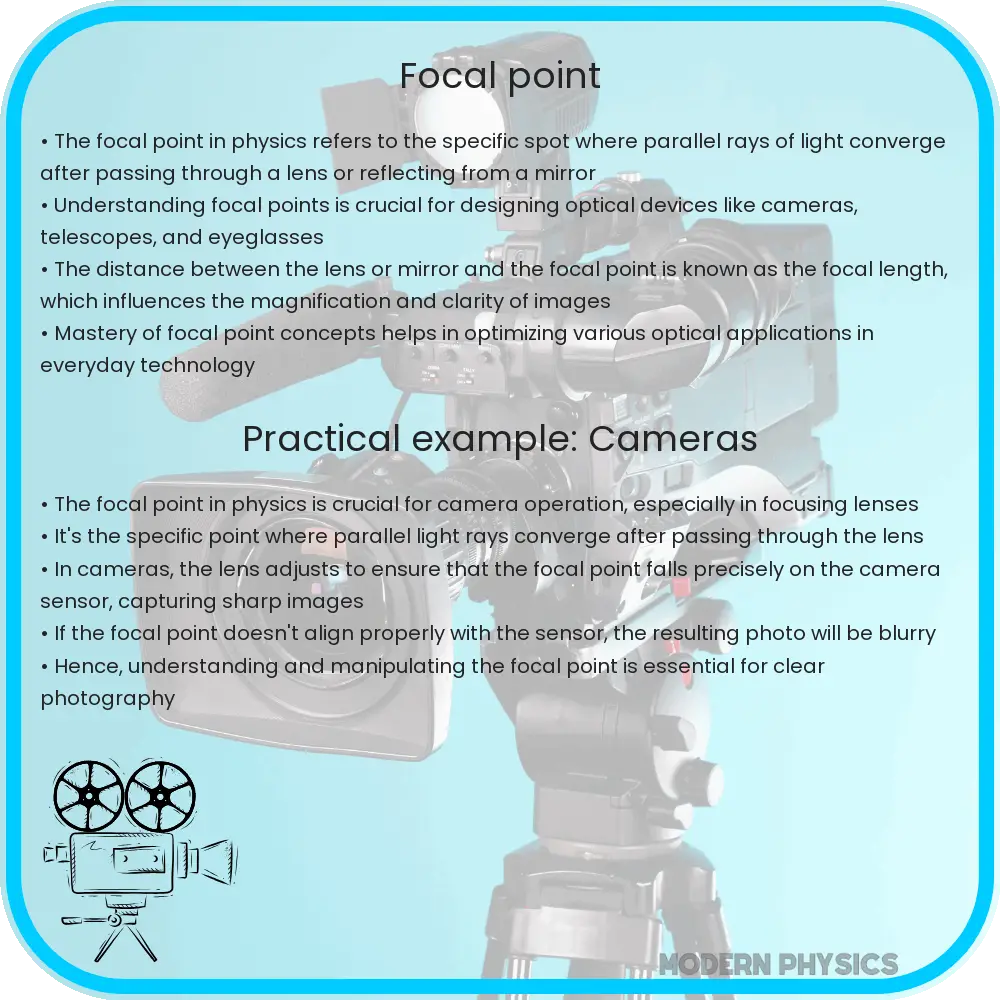The focal point in geometrical optics is the key point where light rays converge or appear to diverge, crucial for lenses and mirrors in forming clear images.

Focal Point in Geometrical Optics: Precision & Clarity
In the fascinating world of geometrical optics, the focal point plays a pivotal role. It’s a key concept that helps us understand how lenses and mirrors manipulate light to form images. Whether it’s the lens of a camera, the lens in our eyes, or a telescope peering into the vast universe, the focal point is integral to their function.
What is the Focal Point?
The focal point, often denoted as F, is the specific point where light rays parallel to the optical axis converge after passing through a lens or reflecting off a mirror. For a converging lens or concave mirror, the light rays meet at the focal point on the axis after refraction or reflection. In contrast, for a diverging lens or convex mirror, the focal point is where the light rays appear to diverge from, once they have passed through the lens or reflected from the mirror.
- Converging Lens (Convex): Light rays parallel to the optical axis converge at the focal point after refraction.
- Diverging Lens (Concave): Light rays parallel to the optical axis appear to diverge from the focal point after refraction.
- Concave Mirror: Light rays parallel to the optical axis converge at the focal point after reflection.
- Convex Mirror: Light rays parallel to the optical axis appear to diverge from the focal point after reflection.
Mathematical Representation
The relation between the focal length, object distance, and image distance in a lens or mirror can be expressed using the lens maker’s formula or the mirror equation:
Lens Maker’s Formula:
\(\frac{1}{f} = (\frac{n-1}{R_1} – \frac{n-1}{R_2})\)
Where:
- \(f\) is the focal length
- \(n\) is the refractive index of the lens material
- \(R_1\) and \(R_2\) are the radii of curvature of the lens surfaces
Mirror Equation:
\(\frac{1}{f} = \frac{1}{d_o} + \frac{1}{d_i}\)
Where:
- \(f\) is the focal length
- \(d_o\) is the object distance
- \(d_i\) is the image distance
In both formulas, a positive \(f\) indicates a converging lens or mirror, while a negative \(f\) represents a diverging lens or mirror.
Precision in Optics
Precision is critical in designing optical systems that use focal points, such as microscopes, cameras, and telescopes. Accurate determination of the focal length and ensuring the precise alignment of optical elements ensure the clarity and accuracy of the formed images.
For instance, in a camera, the lens’ focal length determines how large the subject will appear on the sensor. Different focal lengths can provide different fields of view and magnifications, essential for capturing clear and detailed images. Microscopes use precisely calculated focal points and distances to magnify tiny structures with high clarity.
Applications in Everyday Life
The concept of the focal point is not just theoretical; it is applied in many everyday devices and technologies. Here are some examples:
- Eyeglasses: Eyeglasses correct vision by carefully aligning the focal point of the lens with the retina of the eye, ensuring that images are formed correctly and clearly.
- Magnifying Glass: A simple magnifying glass uses a convex lens to converge light rays to a focal point, magnifying objects placed close to the lens.
- Projectors: Projectors focus light through a lens system onto a screen, adjusting the focal length to produce sharp images at different distances.
- Cameras: Camera lenses move to adjust the focal point and capture images in sharp focus. Whether using manual focus or autofocus systems, understanding and manipulating the focal point is key to professional photography.
- Laser Systems: In laser cutting and engraving machines, precision focusing of laser beams onto a specific focal point allows for fine, accurate work on various materials.
Advanced Imaging Technologies
The mastery of focal points has also paved the way for advanced imaging technologies:
- Medical Imaging: Devices such as optical coherence tomography (OCT) and MRI machines depend on precise focal points to render detailed medical images, aiding in diagnosis and treatment.
- Space Telescopes: Telescopes like the Hubble Space Telescope use precisely aligned mirrors and lenses to capture distant celestial objects’ sharp images, significantly expanding our understanding of the universe.
- Fiber Optics: Communication systems use fiber optics that rely on precise focal lengths to transmit data over long distances with minimal loss.
Conclusion
Understanding the focal point in geometrical optics is fundamental to both theoretical study and practical applications of lenses and mirrors. It forms the backbone of many technological advances, from simple eyeglasses to sophisticated astronomical instruments. Accurately determining and manipulating the focal point allows for the design and creation of devices that significantly enhance our capability to see, capture, and analyze the world around us. By grasping the basics of focal points, you’ll gain a deeper appreciation for the precision required in optics and its myriad applications in everyday life and advanced technologies.
